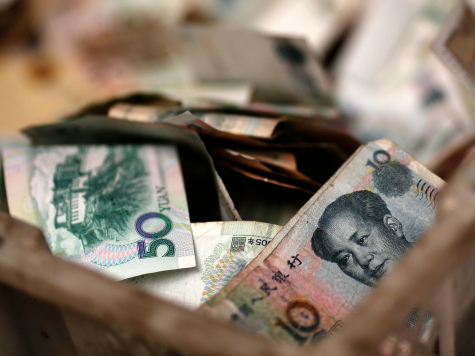China’s National Bureau of Statistics revealed data on August 13th that the nation’s credit plunged by a dramatic and wildly unexpected 86% in July, down to the slowest pace since the 2008 bankruptcy of Lehman Brothers and the start of the global financial crisis. With a collapsing housing sector and falling exports, China now faces a brutal credit crunch.
The collapse in Chinese credit from $320 billion in June to $44.3 billion in July is causing panic across the nation as anecdotal stories from local officials indicate the credit contraction is being “policy-driven.” This would mean that the Chinese central government told its state-owned-banks and (as of 2011) 144,700 state-owned-enterprises that control 43% of China’s total industrial output and business profit to stop expanding.
Since the Lehman Brothers bankruptcy in 2008, China’s state-sponsored export economy has significantly lost competitiveness. As exports fell from 39% of GDP in 2008 to 26% in 2013, the Chinese government made the “policy-driven” decision to plug the gaping economic hole by launching a credit-driven housing and infrastructure construction boom. Funding that boom caused China’s total debt rise from 120% of GDP to over 200% of GDP in June.
Slow-downs in Chinese business expansion have taken place in the past when the Communist Party wanted to curtail high inflation, but this is the first time that loan demand declined after months of sustained and definitely not “policy-driven” declines in home sales, home prices and housing construction in major Chinese cities.
The all-powerful central government has been saying since late 2011 it intends to gradually rein in the construction investment boom and rebalance its economic policy goals to encourage domestic consumption. But the abrupt credit squeeze in July indicates something in China is happening that is beyond the control of the government.
The major reason China has failed to slow its credit boom is the rise of “shadow banking.” A decade ago, China’s state-owned and tightly regulated conventional banks accounted for virtually all the lending in China. But as the Chinese government reined in traditional bank lending from 27% of GDP in 2010 to 18% today, unregulated loans from “shadow bank” trusts, leasing companies, credit-guarantee firms, and money-market funds fueled real estate speculation by expanding from 3% to 8% of GDP.
Traditional bank loans in China required the buyers to actually live in the home, whereas much of the real estate activity over the last six years has been to speculators. The China vacancy rate reached 22.4%, or 49 million units, for sold residential homes in urban areas, according to a 2013 nationwide survey by researchers from China’s Southwestern University of Finance and Economics.
China’s National Bureau of Statistics officially reported in May that home prices fell modestly in 55 of 70 cities. Despite one million new housing units being completed each month, July home sales in China plunged by 17.9% versus June. Home prices in Shanghai, the nation’s most important business center, have fallen by 10.5% over the last twelve months. The looming glut is putting huge pressure on both the heavily-indebted speculators that own vacant properties and “white knuckle” shadow banking lenders that charge exorbitant interest rates.
No one knows how large the shadow bank losses could be, but China’s ten largest state-owned banks reported overdue loans reached $94 billion at the end of 2013, a 21% increase from a year earlier. At the time, real estate was supposed to be rising in value.
“Overdue loans are a leading indicator of asset-quality deterioration and show the rising liquidity constraints among borrowers,” said Liao Qiang, a Beijing-based director at Standard & Poor’s. “While we believe Chinese banks’ credit woes will unfold gradually, the disturbing thing is that the end is nowhere in sight.”
The Chinese Communist Party says it can manage the rebalancing of the Chinese economy toward greater dependence on domestic consumption. Despite a huge effort by the United States government to cushion the 2008 real estate collapse, it took years of economic misery and bank restructuring for America to begin to recover. But no Chinese government has ever demonstrated an ability to manage the combination of a collapsing housing sector, falling export growth, and a credit crunch.
The author will respond to reader comments.

COMMENTS
Please let us know if you're having issues with commenting.